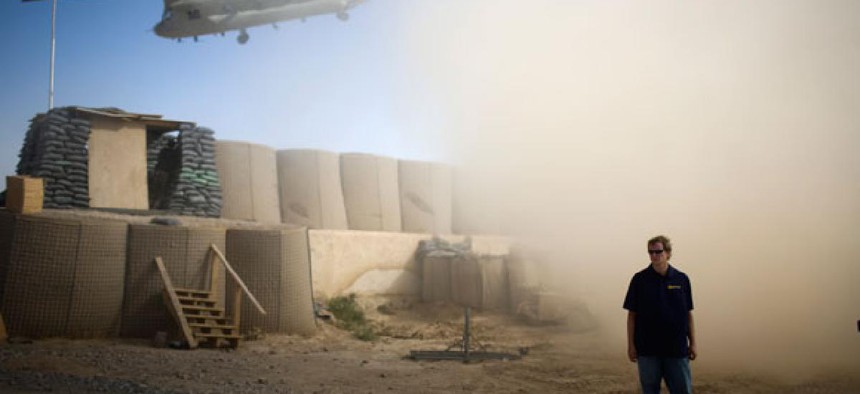Defense Contractors Vastly Outnumber Troops in Afghanistan

A U.S. contractor stands while a helicopter departs over the gatepost at Combat Outpost Terra Nova in Kandahar, Afghanistan. Rodrigo Abd/AP File Photo
The Pentagon spent $160 billion on contractor support for two wars between 2007 and 2012.
For every U.S. service member serving in Afghanistan, there are 1.6 Defense contractors on the ground (and on the payroll) in supporting roles. Contractors make up 62 percent of the force there -- 108,000 versus 65,700 troops, watchdog agency reports reveal.
The Congressional Research Service, in a May 17 report obtained by Steven Aftergood of the Federation of American Scientists, said that the Pentagon spent $159.6 billion on contractor support in Afghanistan and Iraq from 2007 through 2012. A Government Accountability Office report released Wednesday said the Pentagon spent a total of $195 billion on contract services in 2010, double what it spent in 2001. Spending on contract services declined to $174 billion in 2012, GAO said.
Both reports faulted the Pentagon for its inability to provide accurate data on the total number of contractors employed by the Defense Department and the missions those contractors perform.
“Current databases are not sufficiently customized to track important contract data. Even when information is tracked, questions remain as to the reliability of the information,” CRS reported.
One problem is the military services use different methodologies to track contractors. “DOD components used various methods and data sources, including their inventories of contracted services, to estimate contractor [full time equivalents] for budget submissions,” GAO said.
Its analysis found that “the contractor FTE estimates have significant limitations and do not accurately reflect the number of contractors providing services to DOD.” Those limitations included estimating techniques based on potentially inaccurate inventory data, GAO said.
Contract personnel provide a wide range of services, including transportation, construction and base support functions as well as intelligence analysis and private security.
CRS noted that by using contractors on an as-needed basis, the Pentagon can save money and free uniformed personnel to focus on combat operations. The department also can use contractors with specialized skills, such as linguists or weapons maintenance experts, to quickly support specific battlefield needs.
But CRS noted that many analysts believe contractors undermined the military’s credibility and effectiveness in both Iraq and Afghanistan and it criticized Defense for poor planning in how it uses contractors in operational support roles.
“The ineffective use of contractors can prevent troops from receiving what they need, when they need it, and can lead to the wasteful spending of billions of dollars,” CRS said.
GAO said the Pentagon needs to develop a “strategic human capital management” plan that determines the appropriate mix of military, civilian, and contractor workforces and the functions of each.
In a response to the GAO report, Rick Robbins, the department’s director of force manning and requirements, said Defense officials recognized that the contractor FTE information provided in the department’s 2013 and 2014 budget submissions had significant limitations.
He said a reliable, current inventory of contractor FTEs is a fundamental building block for developing future contractor FTE estimates and noted that the department has initiated efforts to improve inventory data by collecting it directly from contractors, using the Army’s Contractor Manpower Reporting Application as a model.
NEXT STORY: Strangling Google in China?






